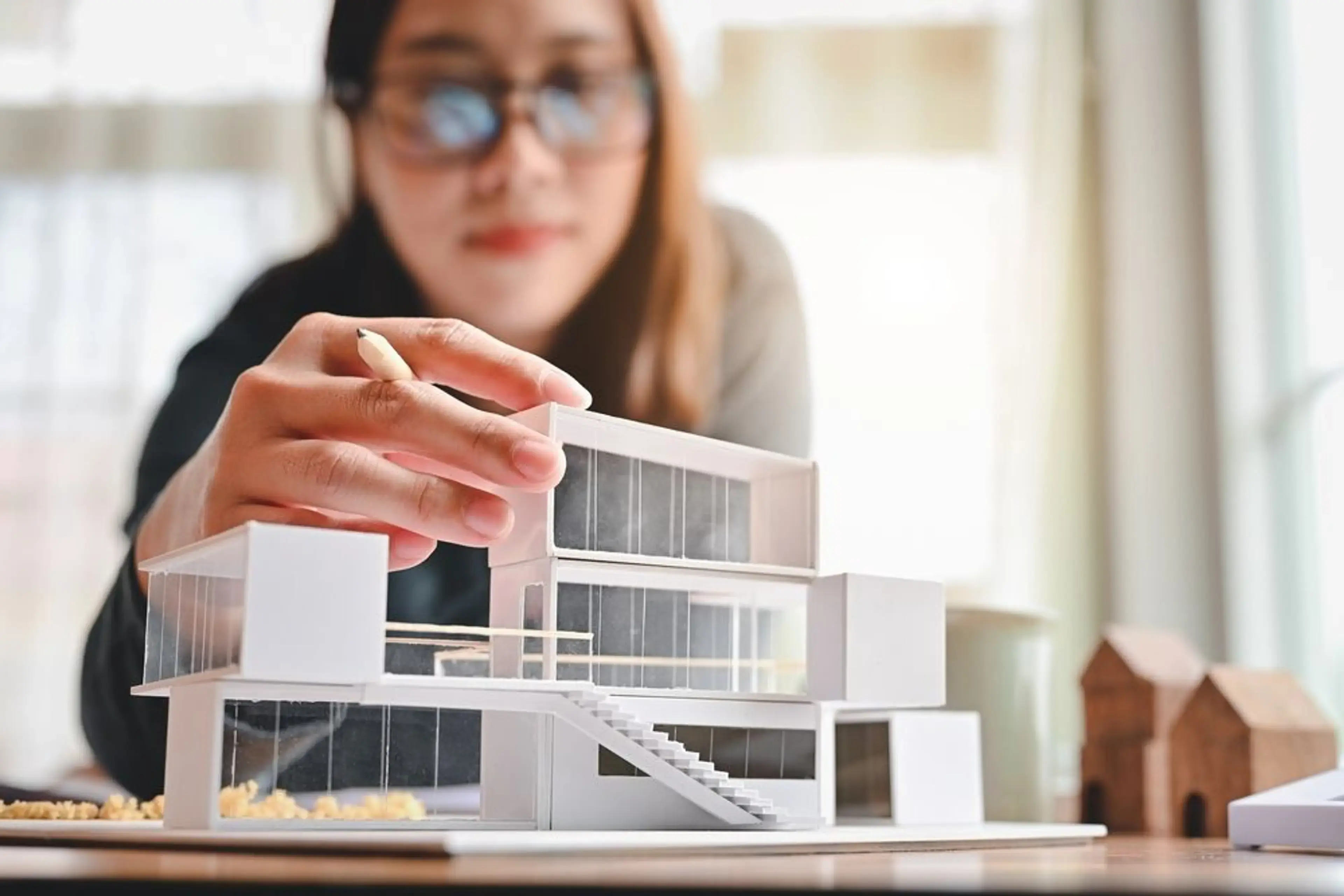Architect Checklist for Recent Commercial Projects
Architect Checklist for Recent Commercial Projects
Blog Article
Understanding the Diverse Job Paths Available for Aspiring Architect
As an aspiring Architect, you have a globe of occupation paths awaiting you. Each path supplies distinct challenges and possibilities to apply your creative thinking and technological know-how. Whether you're drawn to traditional design or the nuances of lasting style, there's a niche that straightens with your passions. Recognizing these varied options can form your professional trip, however which direction will you pick to discover initially?
Standard Architecture: Designing Structures and structures
Typical design concentrates on making buildings and structures that blend capability with visual appeal. As you explore this area, you'll value the elaborate equilibrium in between kind and function. You'll find out to draw ideas from historical designs, incorporating components like proportion, products, and workmanship. Your styles can mirror cultural heritage, showcasing regional customs while fulfilling modern needs.
You'll establish skills in drafting, model-making, and site analysis, allowing you to visualize and communicate your ideas efficiently. Engaging with clients, you'll need to understand their vision and translate it into viable layouts.
Moreover, developing codes and sustainability practices are vital in your work, ensuring your frameworks are secure and eco-friendly. As you grow in your profession, you'll find chances in property, industrial, or also reconstruction projects, each offering distinct obstacles. Accepting conventional architecture leads the way for a satisfying profession that admires the past while forming the future.
Urban Planning: Forming Areas and Public Spaces
As a hopeful Architect, you can play a necessary duty as an urban organizer, transforming how areas function and interact. By using neighborhood engagement approaches, you'll ensure that residents have a voice fit their setting. And also, integrating sustainable layout principles will certainly assist produce spaces that not just satisfy today's requirements but also secure the future.
Function of Urban Planners
While numerous may assume of engineers as the sole dreamers behind structures, metropolitan coordinators play a vital function in shaping the broader landscape of areas and public areas. They analyze land usage, zoning laws, and area requires to create sustainable settings that boost lifestyle. By working together with numerous stakeholders, you'll aid develop parks, transport systems, and residential areas that advertise social communication and ease of access. Urban coordinators additionally focus on environmental factors to consider, guaranteeing that advancements incorporate green spaces and assistance biodiversity. Your competence in spatial layout and neighborhood characteristics allows you to imagine future growth while protecting social heritage. In this important role, you'll directly affect exactly how individuals experience their surroundings, making every job a possibility for favorable adjustment.
Community Involvement Approaches
Efficient community engagement methods are crucial for city organizers to guarantee that the voices of locals are heard and valued in the planning process. To cultivate purposeful dialogue, you need to prioritize open online forums and workshops where area participants can express their concepts and concerns. By actively integrating and paying attention comments, you'll develop areas that show the community's requirements, inevitably leading to even more sustainable and successful metropolitan atmospheres.
Sustainable Style Concepts
When making city areas, integrating sustainable design concepts is vital for producing atmospheres that flourish both ecologically and socially. Take into consideration incorporating eco-friendly spaces, like parks and yards, to improve biodiversity and improve air quality.
Designing with water conservation in mind is also essential-- assume regarding rain yards and permeable surface areas to handle stormwater. Including area participants during the preparation procedure guarantees that the rooms you develop meet their needs and encourage social communication. By accepting these principles, you'll add to lively, sustainable city landscapes that benefit every person.

Landscape Architecture: Creating Sustainable Outside Environments
As you explore landscape style, you'll uncover essential layout principles that develop beautiful and functional outside spaces. Sustainable techniques play an important role in ensuring these settings grow while decreasing ecological effect. Plus, you'll locate a range of career possibilities that enable you to make a real distinction in how individuals communicate with nature.
Layout Principles in Landscape
Understanding layout principles in landscape style is necessary for creating lasting outdoor atmospheres that harmonize with nature. You'll require to contemplate elements like range, proportion, and equilibrium to assure your designs feel natural and inviting. Integrating indigenous plants not only improves biodiversity but likewise reduces water usage, making your landscape resistant. Think of the flow of room and exactly how individuals engage with it; paths and seating areas need to invite expedition and relaxation. Furthermore, focus on seasonal adjustments, making with materials that match the surroundings year-round (Architect). By prioritizing sustainability and appearances, you can create outside rooms that enrich the community and advertise health. Embracing these concepts will certainly set a solid foundation for your job in landscape architecture.
Lasting Practices Introduction
Sustainable methods in landscape design not only focus on appearances yet additionally focus on environmental health and wellness and resource conservation. By incorporating native plants, you boost biodiversity and lower the requirement for chemical fertilizers and pesticides. Implementing reliable watering systems assists conserve water and decreases drainage, securing close-by ecosystems. You can design rooms that advertise soil health, such as using natural products and practicing permaculture principles. In addition, integrating environment-friendly facilities, like rain yards and permeable pavements, aids in stormwater management and reduces urban heat. You contribute to a healthier planet and supply rooms that promote community connection when you develop outdoor settings with sustainability in mind. Ultimately, these techniques guarantee your styles profit both people and the setting for many years ahead.
Career Opportunities Exploration
With a solid structure in sustainable methods, landscape style offers a variety of occupation courses that enable you to make a significant influence on the environment. You might work as a landscape developer, producing visually pleasing and functional outside rooms, or specialize in ecological reconstruction, aiding to revive damaged ecological communities. Urban organizers typically collaborate with landscape architects to produce eco-friendly areas in metropolitan settings, enhancing city livability. If you're passionate about education, consider becoming a landscape architecture educator, motivating future generations. In addition, you could deal with nonprofits concentrated on ecological sustainability or involve in research study to innovate new methods. Each path not only shapes lovely settings yet likewise promotes a much healthier world for future generations.
Sustainable Layout: Concentrating On Eco-Friendly Practices
As you explore your occupation in design, embracing environmentally friendly techniques can establish you apart in a competitive area. Lasting design concentrates on producing structures that decrease ecological impact while boosting passenger well-being. By including sustainable materials, energy-efficient systems, and lasting structure methods, you'll add to a greener future.
Start by acquiring knowledge of environment-friendly accreditations like LEED or BREEAM, which can bolster your qualifications. Think about just how natural light, air flow, and thermal performance can enhance style. Collaborate with engineers and ecological consultants to introduce solutions that decrease waste and preserve sources.
Don't neglect the significance of area participation-- engaging local stakeholders can influence layouts that harmonize with the atmosphere. As customers significantly focus on sustainability, your knowledge in green practices will not only bring in projects but likewise accomplish your passion for accountable design. Welcome this crucial aspect of the occupation, and enjoy your job flourish.
Historical Preservation: Shielding and Recovering Social Heritage
While you start on your architectural trip, consider the essential role of historic preservation in maintaining our social heritage. This area concentrates on the defense and restoration of substantial structures, websites, and frameworks that inform the tales of our past. By engaging in historic preservation, you'll assist secure the architectural legacy that shapes community identity.
As a historic preservation Architect, you'll assess historic importance and assess the problem of structures. You'll function closely with conservationists and chroniclers to ensure authentic reconstruction methods are employed. This job course allows you to mix imagination with study, allowing you to design options that respect initial materials and workmanship.
Your work not only adds to sustainability by reusing existing structures but additionally fosters a sense of satisfaction within neighborhoods. Welcoming this path will certainly aid Architect you become a guardian of background, preserving the stories and aesthetic appeals that improve our lives.
Interior Design: Enhancing Indoor Spaces
Historical preservation and interior design both share a dedication to enhancing the constructed setting, but they concentrate on various aspects. While historic conservation emphasizes preserving a framework's historical and cultural worth, indoor architecture zeroes in on enhancing interior rooms for functionality and looks.
As an ambitious Architect, you'll find that interior design permits you to mix creativity with technical skills. You'll make rooms that not only look good yet additionally promote convenience and performance. This area involves comprehending just how light, shade, and materials engage within a room, influencing state of mind and usability.
You'll deal with different tasks, from household homes to commercial workplaces, guaranteeing that each atmosphere fulfills the needs of its owners. By prioritizing individual experience, you can change interiors into inspiring and functional areas, making a significant influence on just how people communicate with their surroundings. Accept the possibility to improve interior environments and shape the way individuals live and work.
Industrial Style: Combining Capability With Visual Appeals
Commercial layout plays a necessary role in creating items that effortlessly blend appearances with capability, guaranteeing that what you make use of everyday is not just aesthetically enticing however additionally useful. As a hopeful Architect, you might involve on your own in this area, focusing on designing whatever from furnishings to customer electronic devices. Your work entails comprehending individual requirements, materials, and manufacturing procedures, enabling you to develop ingenious remedies that boost everyday experiences.
In commercial layout, you'll usually team up with engineers, manufacturers, and marketing professionals, ensuring that your designs are not just attractive however also feasible. This job path provides a dynamic setting where creative thinking fulfills functionality, making it a satisfying choice for engineers interested in shaping the products of tomorrow.
Frequently Asked Inquiries
What Educational Accreditations Do I Need to Become an Engineer?
To end up being an architect, you'll need a professional degree in architecture, normally a Bachelor's or Master's. Additionally, you'll have to complete an internship and pass the Architect Registration Exam to exercise legally.
Are There Qualification Needs for Different Architectural Job Paths?
Yes, there're certification demands for different architectural courses. Architect. You'll need to pass exams, total internships, and occasionally pursue specialized training, relying on your chosen emphasis, like landscape architecture, metropolitan design, or historical preservation
What Software Program Skills Are Important for Engineers Today?

Exactly How Can I Gain Practical Experience While Studying Design?
You can gain sensible experience by interning at architectural companies, taking part in design competitors, volunteering for neighborhood projects, or working together with classmates on real-world tasks. These possibilities enhance your abilities and build beneficial connections in the sector.
What Job Opportunities Exist Outdoors Traditional Design Firms?
You can explore try this site numerous job possibilities outside standard architecture companies, like urban planning, interior decoration, landscape style, building monitoring, realty advancement, and even roles in sustainability consulting. Each deals one-of-a-kind challenges and benefits.
Whether you're attracted to traditional design or the subtleties anchor of sustainable design, there's a particular niche that aligns with your rate of interests.When making urban spaces, integrating lasting layout concepts is important for developing environments that flourish both ecologically and socially.As you check out landscape style, you'll uncover important style concepts that develop stunning and practical outside rooms.Understanding design concepts in landscape design is crucial for producing lasting exterior environments that harmonize with nature.In industrial style, you'll usually collaborate with manufacturers, marketing experts, and engineers, making certain that your layouts are not only attractive however additionally possible.
Report this page